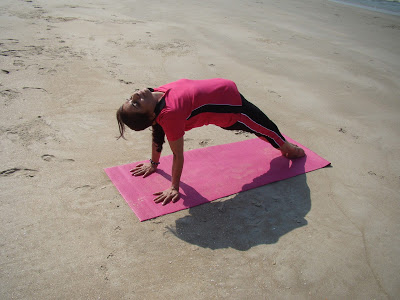By
Dr Rita Khanna,
(36 years experience in Teaching Yoga)
Yoga…A Science of Therapy

Yoga has been internationally accepted as a therapeutic science which touches physical, mental, emotional, intellectual, social, psychological and spiritual levels. In many countries scientific and medical research is now being conducted into various Yogic practices. They found that Yoga had a tremendous influence on the physical and mental body. The Yoga postures harmonize the endocrine glands and the practice of Pranayama creates a balance in the nervous system.
The effects of Asana and Pranayama on the different organs of the body were also investigated. Scientists have also investigated and assessed the value of Meditation. They have measured the brain waves during deep Meditation and found a predominance of alpha waves, which arise during the state of relaxation. (Alpha waves are a type of brain wave that can be recorded by an electroencephalograph (EEG)).
SALIENT FEATURES OF YOGA THERAPY
Upanishads have described five layers of existence of human being called Panchakoshas. They are Annamaya Kosha, Pranamaya Kosha, Manomaya Kosha, Vijnanamaya Kosha and Anandmaya Kosha. It is believed that diseases arise in Manomaya Kosha (mind) and percolate to Annamayakosha (physical body) because of disturbance in Pranamaya Kosha (Pranic energy channels- Nadi’s).
In Yoga we say there are seventy two thousand channels or Nadis in the body through which the flow of Prana and the flow of mind takes place. Out of these seventy two thousand channels of mental and Pranic energy, ten are considered to be major ones. Out of these ten major channels, three are most important. In Yoga we call them Ida, Pingala and Sushumna. Ida represents mental force, Pingala represents Pranic force and Sushumna represents spiritual force.
To counter the diseases, one needs to regularly practice Yogic practices such as:
• Dehasadhana (Physical practices like Yogasanas, Kriyas, Yog Mudras)
• Pranasadhanas (Pranayama)
• Bhavasadhanas (Prayers, chanting of Hymns, listening to devotional songs)
• Divyasadhana (Change of diet, Meditation, listening to a discourse by a spiritual or Yoga Guru).
YOGIC CONCEPT OF DISEASE
The whole body is a composition of Prana and mind. Pranas are responsible for action and motion in life. The mind is responsible for thinking and feeling. Together, mind and Prana fill this living structure, penetrating it through and through. In Yogic language, disease can be explained as disturbance of flow of Pranic energy. The Pranic energy instead of pervading throughout the whole body equally and steadily flows at an unequal rate. There is either irregular flow of energy, diminished flow of energy or excess flow of energy which causes disease. This is where Yoga works as a master key for physical, mental and emotional well being. The science of Hatha Yoga is based on these twin forces. Pranas can be balanced by the practice of Asanas and Pranayamas. The mental force is balanced by the practice of Concentration and Meditation.
HOW THIS IS POSSIBLE
This body lives on the life force which is not the air you breathe, not oxygen, but bioplasm (the living material through which every form of life manifest itself). This life force is generated in everyone at the time of conception. It is part of the cosmic force. If there were no life force, everything would disintegrate. This life force is known as Prana. Prana is one part of your existence and mind is the other. If there were no life or mind, you can imagine what would happen to your body. You would not be able to see, even though you have eyes. You would neither be able to speak, hear, breathe, touch, smell or know even though you have all the organs. The physical body does not move on the basis of the brain, heart, lungs, hands or feet. After all, a dead person has all these. So, in this physical body there are two forces and a balance must be maintained between them.
If the Prana or mind is low, you are sick or abnormal. Prana and mind can be compared to the two wires conducting electricity. In order to have light, the positive and negative cables must carry the same voltage. Therefore, to have a healthy body and a strong peaceful mind it is most important that the Pranic and mental forces are kept in balance. The purpose of Hatha Yoga, Asana and Pranayama is to create and maintain this balance so that all the systems of the physical body are reconditioned.
RESTORING THE BALANCE
All over the world people are living in a state of terror, fright, anxiety, passion, tension, insecurity, uncertainty, suspicion and so on. These states influence man’s physiological structure, and cause most of the diseases that we suffer from today. In this context Yoga comes to us as a great panacea. When we practice Yoga, the changes in the physical body are clear, they are earmarked. The behaviour of the heart, consumption of oxygen, rate of respiration, reactions of the nervous system, secretions of hormones, alteration of brain waves, and all the systems of the physical body are influenced and undergo certain changes. This has a beneficial effect on most disease states.
DEFINITION OF DISEASE
Yoga has its own definition. Disease manifests in the body but does not originate in the body. Disease originates with a state of imbalance. There may be disharmony between the nervous systems or an imbalance in the hormonal secretions, or in the digestive processes. As such, we define disease in a subtle manner and we treat it according to its nature.
FOR EXAMPLE
1. When we treat a diabetic patient we don’t treat him for a deficiency of insulin. Although we know that it is a deficiency in insulin. We also know that the sympathetic and parasympathetic nervous systems are controlled by higher centres. When these centers fail to activate the nervous system properly, then a deficiency of hormones in a particular area results. We also know that its root cause is stress and strain which is responsible. It means that Yoga doesn’t treat one part of the body, it treats as a whole.
2. When we treat a mental patient suffering from psychosis, neurosis or a nervous breakdown, we take him as a personality, a human being, an individual who can think and feel. We take him deeper into his own mind through the practices of concentration and Meditation, bringing him to the root of his illness. If a person is suffering from high anxiety, we don’t prescribe practices to induce an immediate state of tranquility. Rather, we try to explode his personality, to express what remains dormant in the back of his mind. This is possible with the practice of Concentration, such as Mantra, which is part of Yoga. (Mantra is a very powerful instrument. Through the practice of Mantra, we try to explode the deeper phases of the consciousness. When the inner states of mind are exploded then one comes face to face with all the thoughts, distractions, passions and repressions deep within.)
THE PHYSICAL BODY
The physical body is influenced by the human mind. It is the sentiments, the emotions, feelings and objectives, passions, fears, anxieties and worries in the mind which create physiological changes in the body. The adrenal, thyroid and pituitary secretions have a natural flow and order. A thought can and does influence the workings of our physical body. Through the practice of Yoga-nidra (psychic sleep), certain Pranayamas and chanting of Mantra, we have been able to alter and harmonise the pattern of brain waves. In the University of Barcelona they have exposed people to medical tests and investigations while the Mantra OM was being chanted. The sound was recorded by sophisticated instruments and they found that when ‘O’ was being intoned alpha brain waves were predominant, and when ‘M’ was intoned the pattern changed into theta waves (Theta Brain Waves are the second slowest frequency of brain waves. These occur in sleep and dominant in our highest state of meditation).
HOW DO ALPHA, THETA WAVES & YOGA-NIDRA RELATE TO DIFFERENT PHYSIOLOGICAL CONDITIONS
Alpha and theta rhythm automatically reduce the blood pressure of a person suffering from hypertension. Since high blood pressure is a consequence of hypertension, it can only be balanced by bringing the alpha rhythm into action, and this can be achieved through the practice of Meditation. If one is suffering from hypertension and blood pressure, sit him down quietly in an easy chair. Let him close his eyes and chant OM for a short time. After fifteen to twenty minutes when you take his blood pressure, you’ll be surprised to see that certainly OM has done the job.
In the same manner, research is also being conducted into Yoga-nidra. Yoga-nidra is a very important practice and medical investigations have clearly shown that it is not hypnosis, but an entirely different technique. Yoga-nidra is a practice where you are allowed to relax, but not to sleep. Sleep is not relaxation, and relaxation can definitely occur in an awakened state. Yoga-nidra is very effective for people suffering from hypertension. Half an hour of Yoga-nidra everyday can give permanent relief to these people.
For Yoga-nidra, lie down in the supine position and follow the awareness through all the different parts of the body. As a result a state of relaxation arises and the brain undergoes a corresponding change. During the practice of Yoga-nidra we have seen delta waves appear a few times, especially if the subject is tired. Delta waves are usually associated with the deepest stages of sleep and it is the slowest of all five brainwave frequencies. Sometimes theta waves also appear, but alpha waves usually predominate.
ADOPT FOLLOWING YOGIC METHODS TO MAINTAIN THE BALANCE
Neti (the nasal Kriya)
In this practice water is passed from one nostril to another, or a catheter is passed through the nostril into the mouth. This practice is used for migraine, sinusitis, eye problems, sore throat, epilepsy and other disorders of the head.
Dhauti (washing the digestive system)
In Kunjal kriya we drink salty water and then vomit it out. In Vastra dhauti we swallow a thin strip of cloth about six feet long. It’s very effective for asthmatic patients.
Basti( sucking water in through the anus)
This is used mainly for alleviation of piles, fistula and diseases of the rectum.
Trataka (gazing on a fixed point)
This practice develops concentration and helps improve the eyesight.
Nauli(abdominal roll)
This exercise stimulates different parts of the intestines and the benefits are numerous. It has immediate effects on the sexual debility of man. It also maintains the health of the kidneys and bladder.
Kapalbhati( rapid respiration with the emphasis on exhalation)
The purpose of this practice is to purify the frontal region of the brain, and to revitalize and rest the mind. After five minutes of kapalbhati you will find that your mind is very clear, without any confusion. It is especially useful when you are studying for an examination.
Asanas
After the practice of above Yoga techniques, one should begin Asanas.
Pranayama
After Asanas, start Pranayama, and when you are sufficiently accomplished in these, then begin the practice of Meditation.
Meditation
The science of Meditation (Dhyana) is a very important part of Yoga. It has a great effect on the human body and mind. Meditation is not only a psychological or spiritual practice, it is an all round practice for everyone, with or without a religious background. The research that has been carried out on the influence and effects of Meditation on the brain, nervous system and body, has revealed that the practice of Meditation brings a great change in the behaviour of the brain, the sympathetic and parasympathetic nervous systems, as well as the entire personality. It is the most important practice for all mental and spiritual progress. Following are some tips for Meditation:
• Any time of the day, or at fixed times morning and evening, you can practice for ten minutes, not more than that. During these ten minutes you are not going to spend; you are going to invest.
• First of all fix your posture; keep your spinal cord upright and straight. Close your eyes and fix them at the nose tip. That is essential. Don’t move the body; total immobility must be achieved for a period of ten minutes only, not more than that. The whole body should not move. It must become steady, like a statue.
• Next become aware of your natural spontaneous breathing process. Don’t try to breathe in and out. Don’t make any effort to breathe. You breathe all the time, but now you should become aware that you are breathing in and out. Become a witness of the spontaneous breathing process. That’s all, nothing else. Follow the breath awareness for a full ten minutes.
• At the end of this time, come out. You can keep an alarm clock beside you if you like.
• Practice this day in and day out, and if possible after one month you can expose yourself to medical tests before, during and after the practice. If there is computerized polygraph testing available, then everything can be tested simultaneously. You will find total positive changes. Medical and psychological tests are not the only proof of your wellness, your own family members as well as your colleagues in professional life will also notice the change.
IN CONCLUSION
It is a fact that Yoga is a science of therapy, a science of self improvement, and a way to discipline. But besides all this, Yoga is a culture, and every nation must have one. A country with a culture based on Yoga has eternal existence. It can survive through the vicissitudes of life, the accidents of history and the ravages of time. In the coming times, Yoga is going to emerge as a mighty world culture, is going to direct the events of the world’s history, and you have a definite role to play in this. It is up to you to accept this great science with love, with admiration, with hope and with sincerity.




